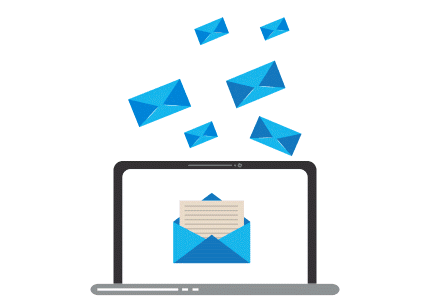In the ever-evolving landscape of digital communication, email remains a cornerstone for both personal and professional interactions. However, with the increasing sophistication of cyber threats and the importance of data security, ensuring that email addresses are associated with legitimate and trustworthy domains is of paramount importance. Welcome to the realm of domain name email validation—a critical practice that fortifies your email security. In this comprehensive guide, we will delve into the intricacies of domain name email validation, offering insights into its significance, best practices, and the tools and techniques needed to safeguard your email communication effectively.
Why Domain Name Email Validation Matters
Before we embark on our journey to understand domain name email validation, it's imperative to comprehend why it holds such a pivotal role in the world of email communication.
1. Email Security: In an era rife with phishing attacks and email-based cybercrimes, verifying the legitimacy of email addresses linked to trusted domains is the first line of defense against potential threats.
2. Data Privacy: For businesses and individuals alike, protecting sensitive information is paramount. Domain name email validation ensures that confidential data is shared only with trustworthy entities.
3. Brand Reputation: Maintaining a secure email ecosystem not only safeguards your organization's reputation but also prevents malicious actors from tarnishing your brand.
4. Regulatory Compliance: Various data protection regulations, such as GDPR, mandate secure handling of personal information. Email validation helps you comply with these regulations.
5. Reliable Communication: Ensuring that emails are sent from legitimate sources and not blacklisted domains is crucial for reliable and uninterrupted communication.
Given these compelling reasons, domain name email validation isn't just an optional security measure—it's an essential practice to protect your online communication.
The Anatomy of Domain Name Email Validation
Domain name email validation primarily revolves around verifying the authenticity of the domain associated with an email address. Here's a breakdown of the process:
1. DNS Lookup: The validation process starts with a DNS (Domain Name System) lookup. It involves querying the DNS records of the domain in the email address.
2. MX Records: The primary focus is on MX (Mail Exchange) records, which specify the mail servers responsible for receiving email messages on behalf of the domain.
3. SPF Records: Sender Policy Framework (SPF) records are examined to determine whether the sender's mail server is authorized to send emails on behalf of the domain.
4. DKIM Signatures: DomainKeys Identified Mail (DKIM) signatures are checked to ensure the email message hasn't been tampered with in transit and is indeed from the domain it claims to be from.
5. DMARC Policies: Domain-based Message Authentication, Reporting, and Conformance (DMARC) policies are scrutinized to ensure the domain owner's email authentication preferences are met.
Best Practices for Domain Name Email Validation
To maximize the benefits of domain name email validation and fortify your email security, consider the following best practices:
1. Implement DMARC: Deploy DMARC policies for your domain to specify how email receivers should handle unauthenticated emails from your domain. This helps prevent email spoofing and phishing attacks.
2. Regular DNS Monitoring: Continuously monitor the DNS records of your domain to detect any unauthorized changes or suspicious activities.
3. Educate Users: Educate employees or users about the importance of domain name email validation and the dangers of interacting with unverified emails.
4. Leverage Email Security Tools: Invest in email security solutions that offer domain name email validation features to automate the process and detect anomalies.
5. Encourage Reporting: Establish a reporting mechanism for users to report suspicious emails, which can help identify potential threats.
Tools and Techniques for Domain Name Email Validation
Several tools and techniques are available to facilitate domain name email validation:
1. DNS Query Tools: Tools like nslookup or online DNS lookup services can help you inspect MX, SPF, and DKIM records for a domain.
2. Email Security Services: Consider using email security services and solutions that offer domain validation features, such as DMARC, SPF, and DKIM checks.
3. Email Authentication Software: Implement email authentication software that automatically validates the authenticity of incoming emails based on domain verification.
4. DMARC Reporting Tools: DMARC reporting and analysis tools can provide insights into email authentication failures and help fine-tune your email security policies.
Commonly Asked Questions
Q1: Can domain name email validation prevent all types of email-related threats?
- While domain name email validation is a powerful security measure, it primarily focuses on verifying the legitimacy of the sending domain. Additional security measures, such as user awareness and anti-phishing tools, are also essential to combat email threats comprehensively.
Q2: How can I set up DMARC for my domain?
- Setting up DMARC involves creating DNS records and specifying how you want unauthenticated emails to be handled. Consult your domain registrar or DNS hosting provider for guidance on configuring DMARC records.
Q3: Are there open-source tools for domain name email validation?
- Yes, there are open-source tools and libraries available for various aspects of domain name email validation, such as OpenDKIM and OpenDMARC.
Q4: What are the potential consequences of not implementing domain name email validation?
- Failing to implement domain name email validation can expose your organization to phishing attacks, email spoofing, data breaches, and reputational damage. It may also lead to non-compliance with data protection regulations.
In conclusion, domain name email validation is the cornerstone of secure and reliable email communication in today's digital landscape. By understanding its significance, adhering to best practices, and leveraging the right tools and techniques, you can fortify your email security, protect sensitive data, and ensure that your organization's reputation remains untarnished. Make domain name email validation an integral part of your email security strategy, and rest assured that your communication remains trustworthy and resilient against threats.



